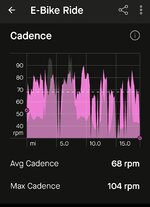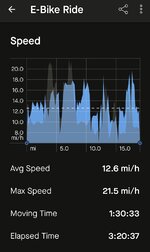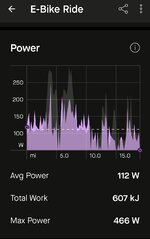Jeremy McCreary
Bought it anyway
- Region
- USA
- City
- Carlsbad, CA
Down to 2 pages on the TCU on my new Vado SL 5.0: (1) the start-up page with ground speed and remaining charge, and (2) this custom rider power/cadence page. Flip back and forth between them, but I'm usually looking at this:

Never saw my own power before, and frankly I'm getting kind of obsessed with it. The real-time rider power display definitely prods me to work harder.
After finishing a ride in the Specialized app, I also get this rider power summary (from yesterday's undulating coast ride, mostly in ECO or OFF):

Have a pretty good understanding of cycling resistances and rider power on a scientific level, and I've read a ton on rider power monitoring in training. But have no practical experience with this kind of data on myself.
Q1. How do YOU do make use of such data in your own riding (any bike)?
Q2. Have you used the Specialized app to estimate your own FTP? Any tricks?
No plans for a formal training regimen, just looking to boost fitness bit by bit without killing the fun of riding this wonderful bike.
Thanks!
Never saw my own power before, and frankly I'm getting kind of obsessed with it. The real-time rider power display definitely prods me to work harder.
After finishing a ride in the Specialized app, I also get this rider power summary (from yesterday's undulating coast ride, mostly in ECO or OFF):
Have a pretty good understanding of cycling resistances and rider power on a scientific level, and I've read a ton on rider power monitoring in training. But have no practical experience with this kind of data on myself.
Q1. How do YOU do make use of such data in your own riding (any bike)?
Q2. Have you used the Specialized app to estimate your own FTP? Any tricks?
No plans for a formal training regimen, just looking to boost fitness bit by bit without killing the fun of riding this wonderful bike.
Thanks!
Last edited:


